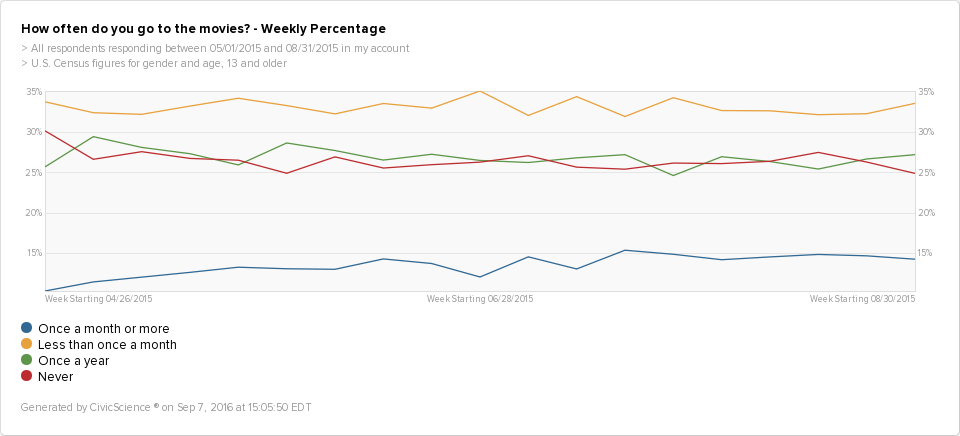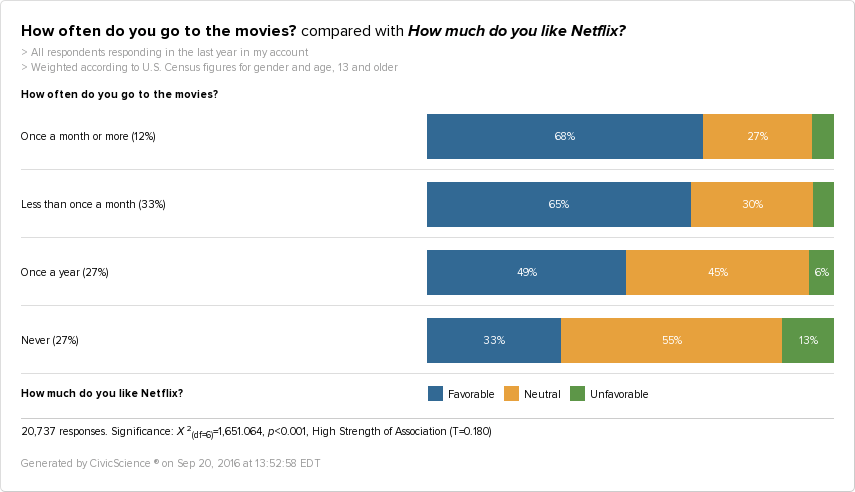During this hottest summer on record, you’d expect movie ticket sales for blockbusters to skyrocket. With a season abundant with remakes, reboots and sequels, why is it being hailed as “The Worst Summer for Movies”?
CivicScience has been asking about moviegoers viewing habits since 2012. With our backlog of data, we hoped to compare summer movie attendance year over year. We took our data on movie viewership from summer 2016 and compared it to summer 2015.
Summer 2016
Summer 2015
These numbers are nearly the exact same year over year. The only difference is a single percent between “Once a year” and “Never”. Given the hand-wringing, this summer season has produced in the film industry, this wasn’t the expected result.
According to Numbers.com 2016’s box office intake overall is projected to exceed 2015’s. The largest blockbuster of last year wasn’t even during the summer. It was everyone’s favorite holiday movie, “The Force Awakens”. The biggest hit of 2016 so far is “Finding Dory,” which has a smaller draw than 2015’s Star Wars extension.
If we look just at summer box office sales, 2016 made 2.6% less than 2015, according to BoxOfficeMojo.com. To me, this doesn’t seem nearly large enough to set off this “sky is falling” mentality from the movie industry.
But falling they proclaim it. Any dip in box office numbers is worth examining, so let’s take a look. While overall box office intakes aren’t suffering massively, it’s the tent poles that are failing.
Did you get a chance to check out “Ben Hur” this summer? No, not the classic but the remake starring Morgan Freeman? Yeah, no one else did either.
In the graphs, “Once a month or more” and “Less than once a month” are telling the story. People report going to the movies with the same frequency they did last year, but based on the box office numbers, they don’t see the big-budget movies that reported less than stellar opening weekends.
Critics and industry insiders all have their take on why people are coming out in droves for “Now You See Me 2,” but theories include franchise fatigue, the theater going experience and continually improving at home streaming experiences.
Is Netflix to Blame?
Fans and critics alike fell for “Stranger Things,” Netflix’s’ small screen answer to the big budget blockbuster. Could it be that the megaplexes lost out due to viewers staying at home?
At home streaming with services like Netflix, do play into the frequency of theater visits, but not in the way we anticipated. The two modes of media consumption aren’t mutually exclusive, and in fact seem to correlate to one another. People who go to the movies once a month or more are more likely to watch Netflix and stream content on their TVs.
We compared “How often do you go to the movies?” with “How much do you like Netflix?” using responses from the last year.
The more frequently people attend the movies, the more likely they are to enjoy Netflix. Given the data above, we’re not sure studios can blame the failure of 2016 summer blockbusters on Netflix programming or streaming content at home.
However, due to the price of tickets and the ease of watching at home, Netflix may make moviegoers more selective when it comes to what movies they’ll see in the theaters.
Social Media and Word of Mouth
If it’s likely not Netflix keeping viewers from seeing the latest blockbuster, why aren’t frequent moviegoers choosing to see summer blockbusters?
What’s more likely to be a strong reason to keep frequent movie theater visitors from blockbusters is the overall poor reviews this summer’s tentpole movies have received.
People who go to the movies once a month or more, as well as those who go less than once a month, are more likely to choose TV shows and movies based on social media influence. It could be that the negative word of mouth dissuaded moviegoers from checking out movies like “Suicide Squad” or “Independence Day: Resurgence.”
This theory is strengthened when you consider the unexpected hits of the summer that sustained box offices numbers week over week. Thrillers “The Shallows,” “Lights Out,” and “Don’t Breathe,” performed better than initially expected. With decent critic reviews and word of mouth on social media, moviegoers gave these non-sequel, non-franchised movies a chance. Same goes for comedies “Bad Moms” and “Sausage Party.”
It’s hard to provide a simple solution or reason for this summer’s movie slump. Make better movies, isn’t helpful or specific, but knowing who goes to the theater can be. Moviegoers enjoy both the theater and streaming experience. It’s worth considering what will bring people to the theater instead of waiting for the movie to hit streaming.
From this summer’s box office, it looks like comedies and thrillers prevail, and many audiences are feeling blockbuster fatigue. It doesn’t seem to be streaming that’s keeping people away, but it could be negative word of mouth on social media and poor reviews from critics.
So are Blockbusters busted? In a way, yes. Given that movie releases are planned years in advance, the next few summers are slated to look very much like this one with remakes, sequels and connected universes. It would seem the millions studios pay for campaigns aren’t paying off. However, creating more social media hype and increasing word of mouth marketing for next year may see success.
But, what the movie industry can take away from this summer is the confidence that audiences will still pay to see smart, small thrillers and comedies in the theater. Hopefully, studios will take a chance on smaller budget movies that still draw crowds in summer 2017.













